Trade Overview
The recent trade involving Trevor Zegras has sent shockwaves through the Anaheim Ducks’ fan community, igniting a firestorm of criticism directed at general manager Pat Verbeek. The deal, which saw the young star and Calder Trophy runner-up exchanged with the Philadelphia Flyers for a fourth-line center and two second-round draft picks, has left many supporters feeling underwhelmed, particularly as there were expectations of a more lucrative return for a player of Zegras’s caliber.
Ownership’s Expectations
Verbeek’s decision comes under increased urgency from team ownership, specifically Henry Samueli, who has expressed a strong desire to see the team return to the playoff race after a series of seasons spent on the sidelines. Samueli, typically not one to voice his opinions publicly, stated during the introduction of new head coach Joel Quenneville the importance of postseason success, emphasizing that both Quenneville and Verbeek must work toward making the playoffs in the upcoming season.
Future Opportunities
Despite the backlash following the Zegras trade, Verbeek believes he has created more opportunities for the franchise to reshape its roster. He indicated that Samueli is supportive of his strategy to restructure the team, providing Verbeek with the freedom needed to make significant moves this offseason. The trade has freed up approximately $3.8 million in salary cap space, giving the Ducks around $36 million to spend this summer, alongside additional draft assets, including the second-round picks numbered 49 and 60, in addition to their own first-round pick at number 10.
Acquisition Targets
One of the focal points for the Ducks’ rebuilding efforts is acquiring a proven scorer, with many eyes on Mitch Marner as a potential target. Marner’s scoring prowess would add much-needed firepower to the Ducks’ forward lineup, especially considering their aim to surround their younger core with experienced talent. However, with Marner potentially commanding a high salary of around $14 million per year, the Ducks will need to weigh their options prudently. The free-agent market also lacks an abundance of high-impact forwards, presenting a challenge for Verbeek as he seeks to build a competitive roster.
Trade Strategy
Verbeek’s willingness to engage in trades signals his determination to improve the team’s quality. He remains open to moving the No. 10 draft pick if it means acquiring a gameplay-ready player. As the offseason progresses, names like Martin Nečas and Bryan Rust may emerge as potential candidates, but any move depends on enhancing the Ducks’ capabilities on the ice.
A New Chapter
Although the trade of Zegras, who struggled with injuries and was seen as stagnant in development, may have stirred controversy, Verbeek envisions that the recruitment process is ongoing. He views the potential transactions not as a burden but as part of a wider plan to enhance the team’s chemistry and performance, aligning with the playing style Quenneville intends to implement. While Zegras’s departure marks the end of an era in some respects, it also opens the door for a new chapter in Anaheim Ducks history, challenging Verbeek to prove he can construct a winning team that meets the lofty expectations set by ownership.




